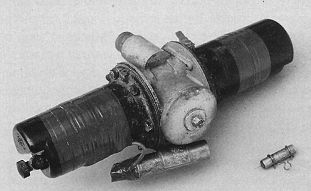

We concluded the previous article with Helga purring beautifully whilst cruising at high speed, 70 mph, in a high ambient, 40°C, on a dead flat landscape, with not a soul and barely a tree in sight, somewhere on the way to Nundroo Roadhouse after departing Nullarbor Roadhouse approximately an hour earlier, where some unhappy sole had recited: "We don't fix cars. We have been sued twice. We only work on aeroplanes and police vehicles. If you break down we will come and get you and it will cost you 400 dollars. If you want a mechanic, the best mechanic between here and Adelaide (1100 km) is at Nundroo (150 km)", when suddenly Helga went all quiet under her bonnet and she rolled to a stop.
A strange feeling when it happens to you for the first time. It was something she had not done before whilst cruising.
Crawling underneath and tapping the pumps had returned the characteristic tic tic tic up till now, when Helga had stalled while idling, but on this occasion not a murmur resulted. A quick check confirmed 12 volts at the pump terminals, so it was not electrical. I noticed that the pump bodies were quite warm, but so were we all. I disconnected the rubber fuel line at the carburettor. The line was dry which seemed to confirm that the problem was loss of fuel supply. That is, it was the same problem which had been haunting us since we left Albany.
I crawled underneath again and applied wet rags to the pumps and continued to tap them. Eventually, after quite some minutes there was a tic, then a tic tic. First bubbles then fuel issued from the disconnected fuel line. Surely vapour lock had to be part of the problem. However there had to be some other contributing factor as there was no sign of such on the 4000 km run from Sydney to Fremantle, where for some of the time, the running conditions, ambient temperature and speed had been the same.
With the fuel line reconnected Helga was purring again and we were soon in Nundroo without further incident. Refuelled and refreshed, after a cool drink, as it was still 40°C, we enquired as to where we would find 'the mechanic' (reported at Nullarbor as the best between there and Adelaide). I was keen to ask him what he knew about SU Fuel Pumps and vapour lock. He had gone fishing we were told. Hot dry Nundroo seemed the most unlikely place for fishing but when we looked at the map, out of curiosity, we found we were still not far from the Southern Ocean although there was nothing on the landscape to indicate this.
We decided to press on, but had not gone far when Helga cut out again while travelling at speed. This time there was nothing I could do to coach her to life. Three young chaps in a utility stopped to see if they could help. They had a rope and as it was getting dark we reluctantly accepted a tow the few miles back to the motel at Nundroo where we checked in, had a shower, then retired to the bar and shouted the three Samaritans a drink. They were operating professional Cray fishing trawlers and so we learnt something of that industry operating in the 'Bight'.
Next morning I sought 'the mechanic' whom had I missed the previous day. He was back from his fishing. His property formed part of the few buildings which made up this remote fuel / motel stop referred to as Nundroo Roadhouse. His house and workshop, a large high ceiling corrugated iron shed, were separated by an open yard space. Scattered around the yard were some thirty to forty vehicles. Each appeared to have had a part removed and all seemed most unlikely to ever see the road again. Not the best advertisement for one's mechanical skills I thought.
I found him at his house but when I queried what he knew of the likelihood of vapour lock in SU Fuel Pumps his reply was: "I know nothing about SU Fuel Pumps!". Strange, I thought they were pretty simple affairs and common on British vehicles. He had another customer - a motorcyclist, whom we had met earlier at Eucla, and was also returning from a trip across our continent. The front tyre of his BMW was de-laminating and it was now too dangerous for him to continue.
As 'the mechanic' was unable to help I returned to Helga parked outside our nearby motel room and set about removing the fuel pump for the third time. Both sides worked perfectly when I applied 12 volts, but I continued to dismantle each pump and reset the diaphragm and toggle stops yet again, as described earlier. I could only think that perhaps I had not got the setting right and that the pumps were not delivering sufficient pressure to prevent a vapour lock developing.
This exercise was performed on my lap while sitting on the only square meter of shaded grass between the motel and a rough camping area in this remote hot dusty environment. I had the motorcyclist as an onlooker when 'the mechanic' arrived to tell him that he had been unable to locate a tyre for his BMW at Ceduna. He would now try Adelaide but it could be a long wait. When he saw that I had the pumps apart and in a dozen pieces he exclaimed "You seem to know more about what to do than I would. You certainly don't need me" and departed.
With the pumps apart I was again surprised to see some burning of the points despite cleaning them at Balladonia. When re-assembled and the toggle settings re-adjusted I applied 12 volts. One side failed to work. I re-checked the diaphragm and toggle settings but still no in /out action. The diaphragm just pulled in and would not release. I lifted one side of the capacitor, which is across the points, and away it went oscillating beautifully the way it should.
At last! I thought. I knew immediately I had found the problem. To confirm I re-connected the capacitor and the diaphragm remained pulled in, then disconnected the capacitor and diaphragm oscillated proving that the capacitor at this moment was obviously short circuited, which I then confirmed with a meter. Thus the stalling all this time was caused by a fault in this tiny capacitor and the difficulty in finding it was that the fault in the capacitor was intermittent.
My guess is that the fault varied between open-circuit and short-circuit. When open-circuited the arc quenching properties of the capacitor was not there, resulting in burning of the contacts I had noticed but could not understand.
When short-circuited the pump coil remained continually energised with the diaphragm pulled in. The pump coil is not designed to be continuously energised so it overheated. The other pump was called on to deliver the fuel needed so it was over-worked thus its coil was also operating above normal temperature. This together with the 40°C air temperatures we were experiencing caused vapour to develop in the small valve chamber between the two pump bodies. The build up of vapour eventually reached the point when the one good pump was unable to deliver fuel and Helga stalled. This only occurred when the intermittent fault in the capacitor was in the shorted state, and initially the heat build up was only sufficient when Helga had stopped after a long run.
Delighted that I had found the problem I walked around to 'the mechanic', held up the faulty component and asked if he had a capacitor, any size would do. His reply, "I wouldn't have anything like that", surprised me, but undisturbed I returned to Helga. I knew I could get home without such, the points would just continue to burn but most likely still function. Then I remembered, Rolls Royce being what they are, there was a spare capacitor mounted on the distributor body. It was much larger and would have to be mounted outside the pump's phenolic end cover but that presented no problem.
 | The tiny capacitor with the intermittent short, the cause of so much trouble, shown in front of Helga's pump with the spare distributor capacitor, as a temporary replacement, strapped to the outside. |
We said good-bye to our BMW friend waiting for a tyre and headed off east, confident that Helga would experience no further fuel problems and that proved to be the case. There was not a moments hesitation from the pumps during the remaining 3000 km. In fact, I only recently removed the pumps from Helga for the photo below.
Our next overnight stops were Streaky Bay then Port Augusta where, to complete the picture on our troublesome CB Radio, which had failed for the third time just prior to Perth, we called at our radio repair man who had performed repair No 2 on the outward journey. The audio IC had failed again and he again considered high charging voltage to be the cause but could not measure more than the 14.9 volts I had monitored, which was well within the specification for the set. This was something to investigate on return to base. I still consider UHF CB worthwhile for outback travel, but all vehicles need high externally mounted high-gain aerials (and sets that work). This is something we didn't have on the Overlander and hence it was not properly trialed.
Of greater interest, certainly to Dawn/MkVI owners, is how Helga's cooling system performed on the return journey, after repairing the leaks found in the new radiator core in Albany. Because of the involvement with the fuel pump I have not said much except that for the first day or so out of Albany things looked promising. Unfortunately, all was not right. Initially the coolant temperature was low and would have remained so if the ambient temperature had not risen much above 30°C, but that was not the case. As the ambient rose so did the coolant temperature.
Because of the steady operating conditions for Helga (flat road and steady high speed) under various but steady daily ambient conditions up to 40°C, I had the opportunity to determine one characteristic of the cooling system. The results are plotted below. Each point on the graph represents the stabilised coolant temperature after more than an hours driving at the steady speed, ambient temperature and road conditions nominated. Each point was verified a number of times.
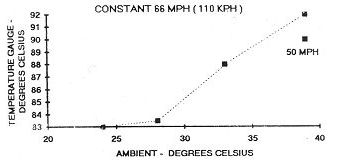 | Graph showing increase in the Dawn's Temperature Gauge reading under constant load (i.e. constant speed, level road) with increasing ambient temperature. |
The results show that as the ambient rose above 28°C the coolant temperature rose quite rapidly and almost linearly. On the days when we experienced the very high ambients it was necessary to drop the speed to limit the coolant temperature. Similarly when hills were encountered, although rare on this run, the coolant temperature rose, and dramatically so in high ambients. So the new core had not solved Helga's overheating problem and its solution still remains a challenge.
I imagine my account of how Helga performed on the 'Pre and Post Rally Dawn Patrol' must sound as though it was a frustrating trip. Actually, it was quite the opposite. Overall I thought Helga performed wonderfully. The technical challenges that occurred I enjoyed, and I still have one I must now really get serious with.
As for Shirley, being the calm girl she is, she took Helga's mechanical hiccups in her stride. She never goes anywhere without some good books, and besides, our route home meandered through the countryside and included Melbourne, Tumut and Canberra etc., where pleasant experiences continued throughout, like the brief sojourn with David and Judy Heuzenroder (SA Branch Members) in their delightful dwelling amongst the South Australian vineyards. There, amongst other things, David described, over his recently purchased Springfield Ghost (154BG, ex Ted Hudson), the fine tuning changes he is contemplating to smarten the already pleasing body lines.
Something for the Record: Helga delivered us safely back to home and produced the
following few statistics:-
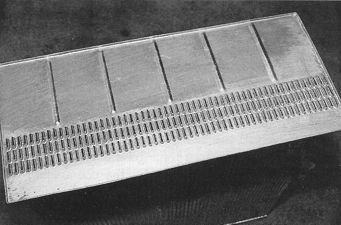 | View of the top plate, before mounting the header tank, of the radiator core supplied by Natra after the Overlander, with more tubes each of greater cross section. Compare with Part 1. |
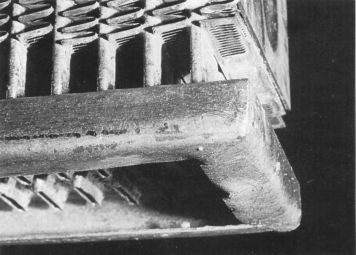 | Close up of the bottom plate of the latest Natra Core. More efficient zig zag as opposed to laminar finning has been used, together with serrations to maximise heat transfer to the air stream. |
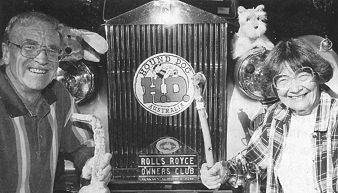 | All three safely back home and even Helga looks pleased with herself. |
Acknowledgements to: Darren of Narrabeen Radiators, Greg at NATRA for their assistance with radiators, a host of members for passing on their experience and the 'Overlanders' for making the 'Coast to Coast' what it was.
Roll on, next 'Overlander'!
Lloyd Missen